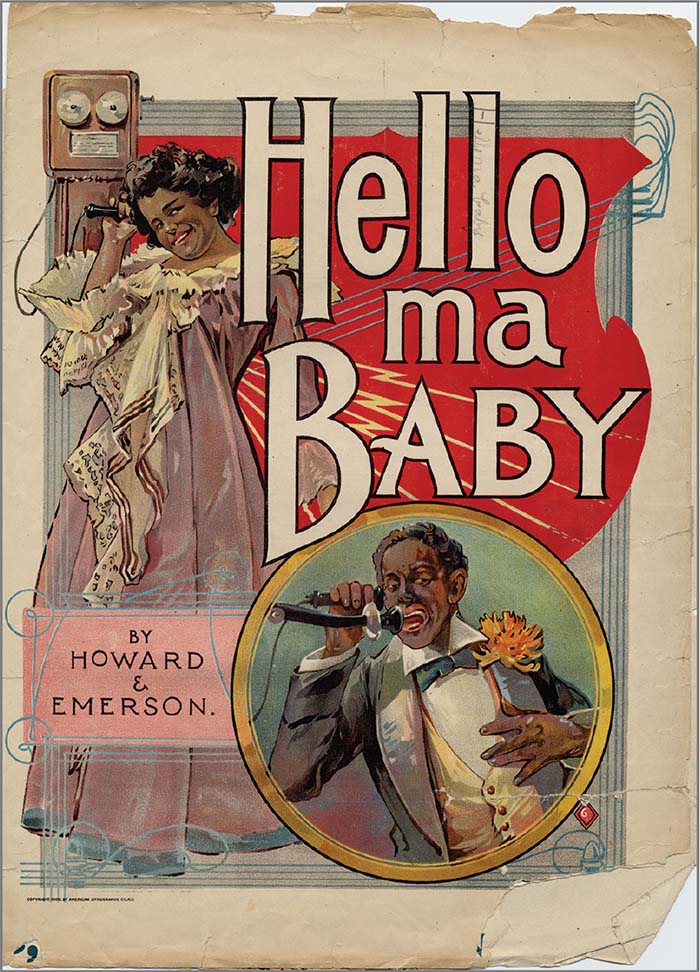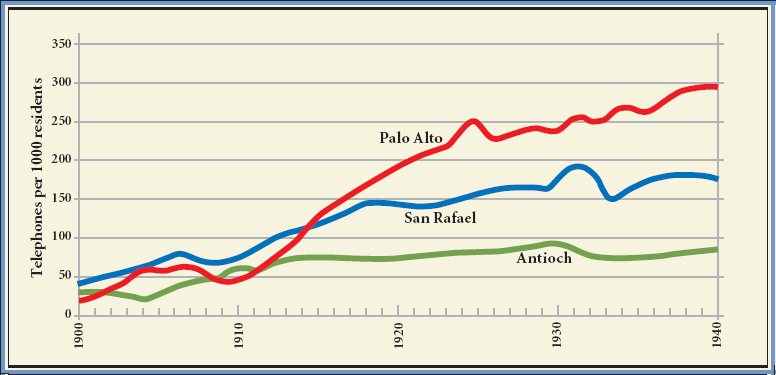America’s History: Printed Page 578
THINKING LIKE A HISTORIAN |  |
America Picks Up the Telephone
New consumer technologies often had different impacts on working-class and rural Americans than they did on the prosperous elite and the middle class. The documents below also suggest some of the ways that telephone use reflected new expectations about women’s roles in the home, workplace, and society.
“Hello Ma Baby” sheet music cover and lyrics, 1899. A popular music hit, this song was written in the voice of an African American man to his girl. The man’s tuxedo is a bit disheveled; in 1899, most white Americans would have assumed he wore it for waiting tables or other service work. The woman wears a dressing gown — not how a respectable lady would want to appear. Nonetheless, the racial depiction here is more modern than those of old-fashioned minstrel shows. The song’s chorus appears below. What changing expectations does it convey about courtship and dating?
 Courtesy of the E. Azalia Hackley Collection of Negro Music, Dance and Drama, Detroit Public Library.
Courtesy of the E. Azalia Hackley Collection of Negro Music, Dance and Drama, Detroit Public Library.Hello! ma Baby, Hello! ma honey, Hello! ma ragtime gal,
Send me a kiss by wire, Baby, my heart’s on fire!
If you refuse me, honey, you’ll lose me, then you’ll be left alone;
Oh baby, telephone, and tell me I’m your own.
“The Perfect Operator,” Saturday Evening Post, July 12, 1930. Katherine Schmitt opened the New York Operator’s School in 1902. Looking back later, she described the qualities sought in operators. What does this document tell us about the values of the emerging corporate workplace?
[The operator] must now be made as nearly as possible a paragon of perfection, a kind of human machine, the exponent of speed and courtesy; a creature spirited enough to move like chain lightning, and with perfect accuracy; docile enough to deny herself the sweet privilege of the last word. She must assume that the subscriber is always right, and even when she knows he is not, her only comeback must be: “Excuse it please,” in the same smiling voice.
“The Mischievous Telephone Girl Makes More Trouble,” Wheeling Register, West Virginia, October 26, 1884. Early operators had to speak to each caller and manually connect the call. Newspapers in the 1880s featured many stories like this one. Telephone companies predominantly hired young white native-born women as operators, or “hello girls.” Many such employees came from the working class.
The girl had been asleep a long time, when somebody called. Looking at the switch board, she observed that No. 1,111 was down, and leisurely raised the phone to her ear. … “Hello! … You bald headed old sinner! What do you want?”
“Dr. Highflyer. No. 2,222.”
“Hello!”
“Hello, Highflyer! My wife is not very well to-night. She has a severe pain in the back of her neck, and complains of a sort of goneness in the abdomen. … What shall I do for her?”
Here the wicked telephone girl switched on a machinist who was telling the owner of a saw mill what he thought ailed his boiler and the answer … was as follows:
“I think she’s covered with scales inside about an inch thick. Let her cool down during the night, and before she fires up in the morning, take a hammer and pound her thoroughly all over, and then take a hose and hitch it on the fire plug and wash her out.”
… The result is that No. 1,111 does not now speak to No. 2,222, and Dr. Highflyer has had the telephone taken out of his house.
Estimated residential telephones in three California locations, 1900–1940. Palo Alto was an affluent university town. Antioch was working-class. San Rafael had a mixed economy, including some industry; it served increasingly as a bedroom community for San Francisco professionals.
 Based on figure 9 from A Social History of the Telephone to 1940, by Claude S. Fischer (Berkeley: University of California Press, 1992). Copyright © 1992 by The Regents of the University of California. Used by permission of the University of California Press.
Based on figure 9 from A Social History of the Telephone to 1940, by Claude S. Fischer (Berkeley: University of California Press, 1992). Copyright © 1992 by The Regents of the University of California. Used by permission of the University of California Press.Telephone etiquette from “A Woman of Fashion,” 1898. At the turn of the century, etiquette authorities began grudgingly to acknowledge the role of telephones in social life. Do you notice any contradictions in the advice below?
Invitations by telephone, for anything other than informal engagements … are hopelessly vulgar. They should be the last resort. Invitations to bicycle or to play golf may be transmitted in this way, and the telephone is a blessing often in adjusting details, or making explanations; but for most social matters the use of the telephone is questionable, at best. Many women will stand with aching feet and irritated brow at a telephone for half an hour rather than write a note which would take four minutes. … Invitation by telephone is one of those modern innovations to which the conservative have never been accustomed, and which shocks elderly, conventional persons still. The convenience of the telephone for quickness and prompt response appeals, however, to so many persons, that it is hopeless and useless to inveigh against it. …If some one’s note has been mislaid or forgotten, there is nothing simpler than to telephone to repair the error, and to explain. It is much speedier than sending a note. … There is no excuse for telephoning an invitation when time is not an object, or when the person invited is not an intimate friend.
Bell Telephone advertisement, 1910. The text from this ad was accompanied by a picture of a young woman on the telephone with young men and women in a room behind her, dancing.
For Social Arrangements: The informal invitation which comes over the phone is generally the most welcome. The Bell service makes it possible to arrange delightful social affairs at the last moment. …
For Impromptu Invitations: The easiest way to get up an informal party, quickly, is by telephone.
Sources: (2) Venus Green, Race on the Line (Durham, NC: Duke University Press, 2001), 67; (3) Wheeling Register, October 26, 1884; (5) Etiquette for Americans (New York: Herbert S. Stone & Co., 1898), 59, 70–71; (6) Claude S. Fischer, America Calling (Berkeley: University of California Press, 1992), 184.
ANALYZING THE EVIDENCE
Question
Consider the audience for each of these sources. Who was intended to read, view, or listen to it? What message does it convey?
Question
Sources 2, 5, and 6 all give advice on how women should behave. Compare these pieces of advice. In what ways are they similar and different?
Question
Based on these sources, which groups of Americans appear to have been affected by the arrival of telephones, and how?
PUTTING IT ALL TOGETHER
Question
Using evidence from these sources and your knowledge of the period, write an essay explaining how the telephone contributed to, and reflected, changes in American women’s social and economic roles.